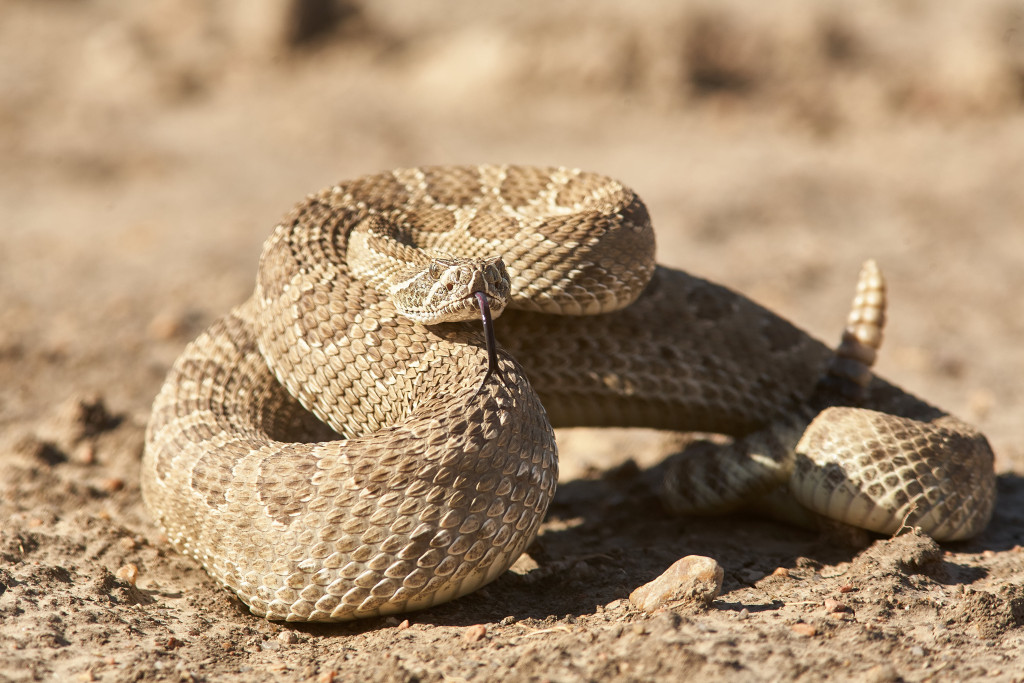Snakes include remarkably fast species that can outpace many predators and prey.
Enlarge

Photo by Jeff Kurrus, Nebraskaland Magazine
By Monica Macoubrie, Wildlife Education Specialist
When we think of fast animals, cheetahs sprinting across the African Savannah or peregrine falcons diving through the sky might come to mind. However, some of the speediest creatures can be found much closer to the ground, slithering through grasslands, forests and deserts. Snakes, often perceived as slow movers, include some remarkably fast species that can outpace many predators and prey.
Strike Speed
Snakes are ambush predators, a hunting strategy that might be perceived as “slow.” However, this doesn’t mean that snakes can’t be fast. Some species have adapted to chase down prey or use speed to evade predators. Some snakes, non-venomous and venomous, have incredibly fast strikes.
Of Nebraska’s 30 snake species, only four are venomous: the prairie rattlesnake, copperhead, massasauga and timber rattlesnake. Strike speed in venomous reptiles is a crucial adaptation that enhances their ability to capture prey and defend against predators efficiently. This swift action is essential because it reduces the chance of injury from struggling prey and allows the reptile to conserve energy.
The speed of a strike, often occurring in milliseconds, is facilitated by specialized muscle structures and highly evolved neuromuscular coordination, which enable precise and powerful movements. For example, vipers and pit vipers utilize a combination of muscle power and elastic recoil mechanisms to achieve rapid extension of their fangs.
This ability to strike quickly also plays a significant role in self-defense, allowing these reptiles to deter or neutralize potential threats effectively. Moreover, the swift delivery of venom is vital for the venom’s effectiveness, as it needs to be injected deep into the prey or predator to ensure rapid immobilization or deterrence.
Eastern Racer (Coluber constrictor)
The eastern racer is celebrated for its exceptional speed and agility, essential traits for survival across various North American habitats. This non-venomous snake can traverse various terrains with remarkable swiftness, often reaching speeds of up to 4 miles per hour.
Speed is essential for this reptile as it actively forages for prey by moving through vegetation with its head raised high, a behavior known as “periscoping.” Its long, slender body with smooth scales reduces friction, allowing it to move effortlessly through grass, leaf litter and shallow water. The eastern racer also has highly developed vision.
The snake’s robust muscles enable rapid acceleration and agile movements, allowing it to catch quick-moving prey such as insects, small mammals and other reptiles. Its coloration, which varies from solid black to blue-gray with lighter underbellies, provides effective camouflage, enabling it to launch surprise attacks or evade predators. The eastern racer is one of the most agile and swift snakes in its ecosystem.

Coachwhip (Masticophis flagellum)
The coachwhip, classified under the genus Masticophis (or Coluber in some taxonomies), stand out as one of North America’s fastest snakes, renowned for its remarkable speed and distinctive whip-like tail. Capable of reaching speeds up to 4 miles per hour, this snake relies on its agility for both hunting and escaping threats.
The coachwhip’s long, slender body, can grow up to 8 feet long, and its smooth, glossy scales reduce drag, allowing for swift, efficient movement across the ground. Powerful muscles support quick bursts of speed and agile maneuvering, essential for pursuing prey such as lizards, small mammals and birds.
Equipped with excellent vision due to its large eyes, coachwhips can detect and react to movement from a considerable distance, enhancing its hunting efficiency and predator awareness.
Coachwhips typically transition from darker shades on the head to lighter tones toward the tail, providing camouflage in the sandy, arid environments of southwestern Nebraska. This color gradient aids in both ambush hunting and predator evasion.

Prairie Rattlesnake (Crotalus viridis)
The prairie rattlesnake is the most common venomous snake in Nebraska. This species can deliver a strike at astonishing speeds, typically taking less than 0.3 seconds from the initial movement to the completion of the strike.
Prairie rattlesnakes also possess specialized sensory organs, including heat-sensitive pits located between their eyes and nostrils, which allow them to detect warm-blooded prey even in low-light conditions. These pits, combined with their keen eyesight, ensure precise targeting during a strike

The “fast snakes” in Nebraska range from the lightning-quick eastern racer to the formidable prairie rattlesnake, showcase a fascinating array of adaptations that allow them to survive and flourish in the Great Plains. Their speed and agility are not only vital for their survival but also highlight the rich biodiversity of Nebraska’s ecosystems.
The post Nebraska’s Fast Snakes appeared first on Nebraskaland Magazine.
















